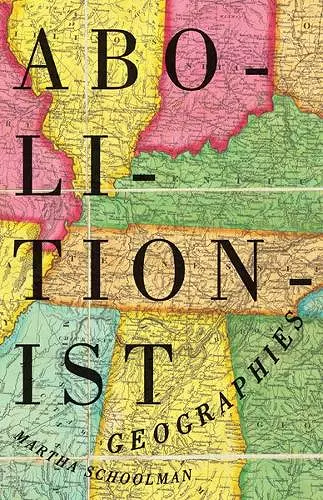Abolitionist Geographies
Format:Paperback
Publisher:University of Minnesota Press
Published:7th Oct '14
Should be back in stock very soon

Traditional narratives of the period leading up to the Civil War are invariably framed in geographical terms. The sectional descriptors of the North, South, and West, like the wartime categories of Union, Confederacy, and border states, mean little without reference to a map of the United States. In Abolitionist Geographies, Martha Schoolman contends that antislavery writers consistently refused those standard terms.
Through the idiom Schoolman names “abolitionist geography,” these writers instead expressed their dissenting views about the westward extension of slavery, the intensification of the internal slave trade, and the passage of the Fugitive Slave Law by appealing to other anachronistic, partial, or entirely fictional north–south and east–west axes. Abolitionism’s West, for instance, rarely reached beyond the Mississippi River, but its East looked to Britain for ideological inspiration, its North habitually traversed the Canadian border, and its South often spanned the geopolitical divide between the United States and the British Caribbean.
Schoolman traces this geography of dissent through the work of Martin Delany, Ralph Waldo Emerson, William Wells Brown, and Harriet Beecher Stowe, among others. Her book explores new relationships between New England transcendentalism and the British West Indies; African-American cosmopolitanism, Britain, and Haiti; sentimental fiction, Ohio, and Liberia; John Brown’s Appalachia and circum-Caribbean marronage. These connections allow us to see clearly for the first time abolitionist literature’s explicit and intentional investment in geography as an idiom of political critique, by turns liberal and radical, practical and utopian.
"Abolitionist Geographies offers exciting new ways of thinking about place, time, politics, and form in the antislavery writings of such important antebellum writers as Emerson, William Wells Brown, Martin Delany, and Stowe. Drawing on recent work in diasporic and hemispheric studies, Schoolman shows how key writers of the time made use of spatial experimentation to conceive of the nation well beyond North and South sectionalism. Abolitionist Geographies poses a fresh challenge to scholars of the period to address matters of nation and geography more complexly." —Robert S. Levine, author of Dislocating Race and Nation
"Whatever else it does in relation to the historiography of antebellum abolition - and indeed it does much - Schoolman’s book teaches us to see this reopening of abolitionist time as an opening of abolitionist space as well."—Antipode
"Martha Schoolman's Abolitionist Geographies is a valuable contribution to the growing body of scholarship that explores connections between the literary and the geographic."—Journal of Historical Geography
"In Schoolman’s skilled reading of its geographies, we now have a map to the abolitionist imagination."—Journal of American Studies
"Schoolman offers a nuanced, historically and geographically informed understanding of abolitionist discourses, and foregrounds the fine details and rough edges that often compromise cursory readings of abolition. [Abolitionist Geographies] is without doubt an important contribution to the renewed scholarly interest in abolitionist literature."—African American Review
"Martha Schoolman’s Abolitionist Geographies contributes significantly to the history of the antislavery movement between British emancipation in 1833 and John Brown’s 1859 Harpers Ferry raid."—Journal of American History
"Sophisticated and meticulously researched."—American Literature
"A nuanced topography that highlights the contradictory, the quotidian, and the contextual strategies ever present in nineteenth-century abolitionist geographies."—Common-Place
"Abolitionist Geographies offers an exciting model of a micropolitical approach to American literatures, where hierarchies, solidarities, and fissures among racial-ethnic groups and what we think of as their literatures emerge in relation to and against regions’ multinational histories."—MELUS
"A timely and engaging study of spatial imaginaries and geographical practices in U.S. antislavery literature. "—Emerson Society Papers
"Schoolman’s ambitious chronology compellingly argues for the importance of space to abolitionist thought, and demonstrates that geography is a means to remap established genealogies of the abolition movement, and to rethink its canonical literature."—Year’s Work in English Studies
ISBN: 9780816680757
Dimensions: 216mm x 140mm x 25mm
Weight: unknown
240 pages